Rick Archer's Note: The Panama Quiz is a fun way to end my
article about the Panama Canal. The purpose of the Quiz is
twofold.
-
If you have found this article by following a link from a search
engine, this quiz will allow you to test your knowledge.
Please note
that in the Answer section, you will find links to different places in my
article to go for further information.
-
If you have just finished reading our Panama Canal article, the
Quiz will not only test your knowledge, it will add a few more
tidbits
to reward you for taking the quiz.
|
Panama Canal
Quiz
Created by Rick Archer, 2011
|
1. Before it was
built, there was an alternative route that closely rivaled
the eventual Panama Canal route. The alternative route was
in:
a) Costa Rica
b) Colombia
c) El Salvador
d) Nicaragua
e) all of the above
2. What do Panama's Culebra
Cut and Colorado's Eisenhower Tunnel have in common?
a) They are both tunnels
b) They both cross the Continental Divide
c) They both link continents
d) They both cross an entire mountain range
e) all of the above
3. "Panamax" is a term for
what?
a) The maximum size a ship
can be to enter the Panama Canal
b) A maximum security prison for dangerous Panamaniacs
c) The number of ships that can use the Canal per day
d) The maximum distance saved by the building of the canal
e) All of the above
4. The Panama Canal runs
east and west. True or False?
5. The Panama Canal is what
kind of canal?
a) a sea level canal
b) an eerie canal
c) a lake and lock canal
d) a root canal
e) a gondola canal
f) an irrigation canal
g) a mountain level canal
6. The distance saved from
NYC to San Francisco by building the Panama Canal was:
a) 02,000 miles
b) 04,000 miles
c) 06,000 miles
d) 08,000 miles
e) 10,000 miles
7. The Panama Canal is how
long?
a) 10 miles
b) 30 miles
c) 50 miles
d) 70 miles
e) 100 miles
8. Which time comes closest
to describing the time it takes a cruise ship to cross the
Panama Canal?
a) one hour
b) three hours
c) five hours
d) seven hours
e) nine hours
9. The first country to
attempt to build a Panama Canal was:
a) Panama
b) France
c) Spain
d) England
e) USA
10. The European who first
discovered the existence of the Pacific Ocean in 1513 was:
a) Vasco de Balboa
b) Christopher Columbus
c) Simon Bolivar
d) Francisco Pizarro
e) Hernan Cortez
f) Ferdinand Magellan
11. The
book "Around the World in 80
Days" was prompted by the completion of what canal?
a) The Suez Canal
b) The Erie Canal
c) The Grand Canal
d) The Panama Canal
e) The Danube Canal
12. Has anyone ever swum the
entire Panama Canal? Yes or
No?
13. Which of the following
is not a lock at the Panama Canal?
a) Miraflores Lock
b) Omar Torrijos Lock
c) Gatun Lock
d) Pedro Miguel Lock
14. The man who helped
convince Teddy Roosevelt of the necessity of building the
Panama Canal was:
a) Alfred Thayer Mahan
b) James Monroe
c) Benjamin Franklin
d) Thomas Jefferson
e) William McKinley
15. America's construction
of the Panama Canal was in serious trouble from the start.
The man who helped rescue the project was:
a) Theodore Roosevelt
b) John Frank Stevens
c) William Gorgas
d) Joseph Bishop
e) George Washington Goethals
f) all of the above
16. Besides being the
narrowest country to separate the Atlantic from the Pacific,
what other feature made Panama attractive for putting the
Canal there?
a) a pre-existing railroad
b) an enormous lake used for crossing
c) a deep river that required no dam and no dredging
d) flat land that was easy to dig
e) lowest spot on the Continental Divide in Central America
f) a long canyon that
required no digging
g) all of the above
17. What was the biggest
obstacle to the completion of the
Panama Canal?
a) disease
b) need to cut a gap through a mountain
c) a highly uncooperative river
d) need to construct untested locks
e) need to construct massive dams
f) lack of a lake for water
g) all of the above
18. The man who conquered
Panama was a...
a) Spanish nobleman
b) Spanish explorer/sea captain
c) Spanish stowaway
d) Spanish map maker
e) Spanish conquistador
19. The ships rise in the
locks by pumping water in to raise the
water level. True or false?
20. The Panama Canal has
been described as the Eighth Wonder of the World and the
greatest engineering achievement since the Great Pyramids of
Egypt. Which of the
following is NOT one of the Seven New Wonders of the World?
a) Chichen Itza
b) Christ the Redeemer
c) Roman Colosseum
d) Great Wall of China
e) Machu Picchu
f) Panama Canal
g) Petra
h) Taj Mahal
21. Central America
is defined as the part of the Americas that links North and
South America together. Which of the following countries is
not considered part of Central America?
a) Belize
b) Mexico
c) Guatemala
d) El Salvador
e) Honduras
f) Nicaragua
g) Costa Rica
h) Panama
i) all the above countries are part of Central America
22. The Chagres
River is the backbone of the Panama Canal. This river is
unusual because:
a) It required little
dredging to form the Panama Canal
b) It is the only river in the world that flows in two
directions
c) It is the only river in the world that empties into two
oceans
d) It is the only river in the world in the shape of the
letter "T"
e) It has two dams
f) All of the above
23. The opening of the
Panama Canal was almost completely ignored. Why was that?
a) the construction had
taken so long no one cared any more
b) World War I had just started
c) President Woodrow Wilson suffered a major stroke that
left him partially paralyzed
d) It was wiped off the front pages by the infamous Black
Sox baseball scandal
e) all of the above
24.
Including the building of the Panama
Railroad from 1850-1855, the French canal attempt of
1880-1890 and the American canal effort, roughly how many
men are said to have died building the railroad and the
canal?
a) less than 10,000
b) 15,000-20,000
c) 25,000-30,000
d) 35,000-40,000
e) more
25. The Panama Canal has one
weakness in particular that worries everyone.
That would be:
a) the size of modern ships
exceeds the size of the locks
b) the rainfall of Panama could easily become insufficient
c) the Canal is far too vulnerable to sabotage and terrorism
d) Panama lies on the San Andreas fault line
e) the nearby volcano Baru is no longer dormant
|


 |
|
| |
|
|
Panama Canal Quiz Answers |
|
|
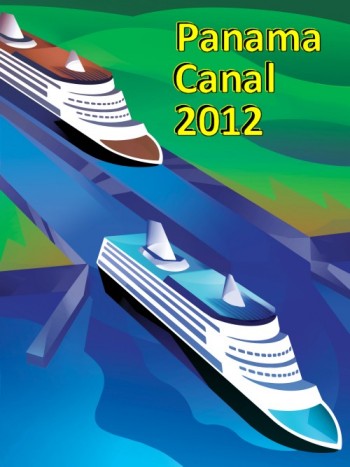 |
1. Before it was built,
there was an alternative route that closely rivaled the
eventual Panama Canal route. The alternative route was
in:
a) Costa Rica
b) Colombia
c) El Salvador
d) Nicaragua
e) all of the above
Answer:
d) Nicaragua
|
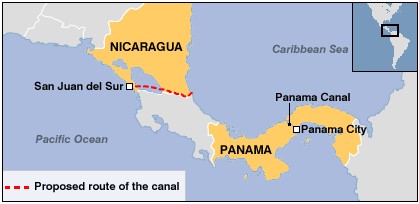 |
| |
2. What do Panama's Culebra
Cut and Colorado's Eisenhower Tunnel have in common?
a) They are both tunnels
b) They both cross the Continental Divide
c) They both link continents
d) They both cross an entire mountain range
e) all of the above
Answer: b) They both cross the Continental Divide
The Eisenhower Tunnel is a vehicular tunnel
approximately 50 miles west of Denver, Colorado, United
States. The tunnel carries Interstate 70 under the
Continental Divide in the Rocky Mountains. With an
elevation of 11,158 feet above sea level, it is one of
the highest vehicular tunnels in the world. The tunnel
is the longest mountain tunnel and highest point on the
US Interstate Highway system. Completed in 1979, it was
one of the last major pieces of the Interstate Highway
system to be completed. The Culebra Cut is Panama's
answer to the Eisenhower Tunnel, crossing Panama's
Continental Divide at 85 feet above sea level.
|
|
| |
|
3. "Panamax" is a term for what?
a) The maximum size a ship can be to enter the Panama
Canal
b) A maximum security prison for dangerous Panamaniacs
c) The number of ships that can use the Canal per day
d) The maximum distance saved by the building of the canal
e) All of the above
Answer:
a) The maximum size a ship can be to enter the Panama
Canal
"Panamax" is a
term for the limit on the size of a ship that can use the
Panama Canal.
The Panama
Canal is currently undergoing further expansion. A new set
of locks will allow transit of larger "post-Panamax" vessels
and the Gatun Lake water supply will also be increased.
Slated for completion at the Canal's 100th Anniversary in
2014, the project will undoubtedly enhance one of the
world's most vital trade.
|
| |
|
4. The Panama Canal runs
east and west. True or False?
Answer:
False
Because the
continents clearly go north and south, common sense has it
that the canal runs east and west.
However, a
simple look at the map shows the isthmus of Panama runs east
and west, so the canal runs north and south.
|
 |
| |
|
5. The Panama Canal is what kind
of canal?
a) a sea level canal
b) an eerie canal
c) a lake and lock canal
d) a root canal
e) a gondola canal
f) an irrigation canal
g) a mountain level canal
Answer:
c) a lake and lock canal
Locks are the
best way to carry a waterway over uneven terrain by raising
and lowering the water level in a series of step-like
chambers. There was a
terrible debate
in the engineering community about whether locks would work
or not.
|
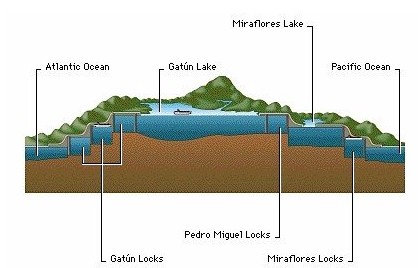 |
| |
|
6. The distance saved
from NYC to San Francisco by building the Panama Canal was:
a) 02,000 miles
b) 04,000 miles
c) 06,000 miles
d) 08,000 miles
e) 10,000 miles
Answer:
d)
8,000 miles!
The Panama Canal
has been called the Greatest Shortcut in history.
Prior to its completion,
the
added distance
for ships sailing from New
York to San Francisco around Cape Horn
at the lower tip of South America versus
through the Panama Canal was
8,000 miles!!
|
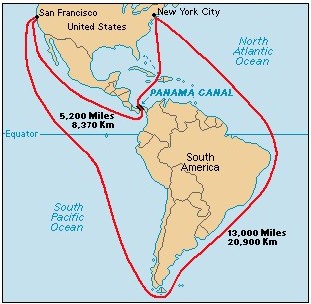 |
| |
|
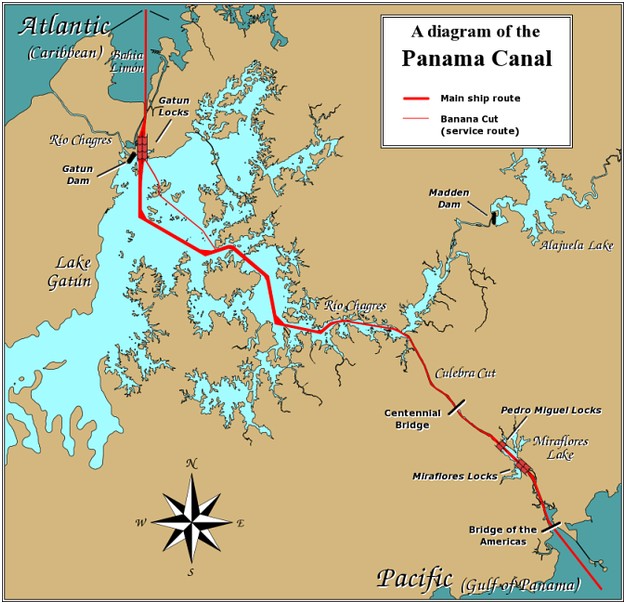 |
7. The Panama Canal is how long?
a) 10 miles
b) 30 miles
c) 50 miles
d) 70 miles
e) 100 miles
Answer:
c) 50 miles
|
| |
|
8. Which time comes closest to
describing the time it takes a cruise ship to cross the
Panama Canal?
a) one hour
b) three hours
c) five hours
d) seven hours
e) nine hours
Answer:
e) nine hours (somewhere
between 8 and 10 hours)
|
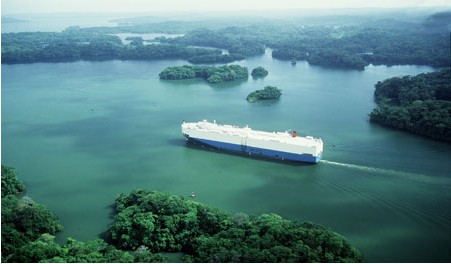 |
| |
|
9. The first country to attempt
to build a Panama Canal was:
a) Panama
b) France
c) Spain
d) England
e) USA
Answer:
b) France
The French
worked on the canal for ten years, 1880-1890. They
didn't get very far. They were only able to excavate
11 miles out of the 50 mile total.
|
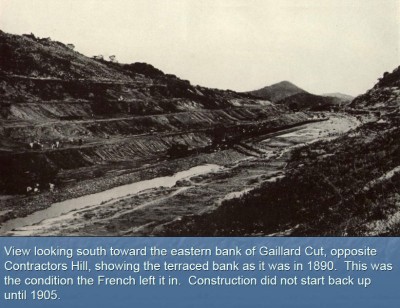 |
| |
|
10. The European who first
discovered the existence of the Pacific Ocean in 1513 was:
a) Vasco de Balboa
b) Christopher Columbus
c) Simon Bolivar
d) Francisco Pizarro
e) Hernan Cortez
f)
Ferdinand Magellan
Answer:
a)
Vasco de Balboa
|
 |
| |
|
11. The book "Around the World
in Eighty Days" was prompted by the completion of what
canal?
a) The Suez Canal
b) The Erie Canal
c) The Grand Canal
d) The Panama Canal
e) The Danube Canal
Answer:
a)
The Suez Canal
The completion of the
Suez Canal concurred with another famous event - the completion of
the first US transcontinental railroad. These two events made
the entire world a much smaller place. A famous dreamer
- Jules Verne - took note and wrote his wonderful
"Around the World in 80 Days", a journey that used both the Suez and
the
railroad developments in the fascinating saga.
|
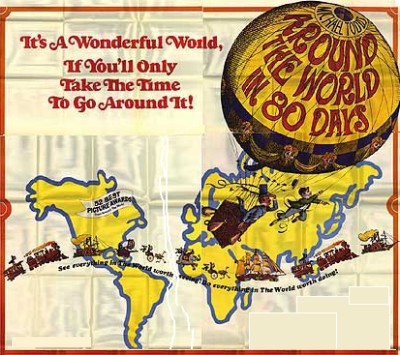 |
| |
|
12. Has anyone ever swum the
entire Panama Canal?
Yes or No?
Yes. Richard
Halliburton who crossed the Canal swimming in 1928.
He paid the lowest toll in the
history of the Panama Canal at 36 cents.
Wouldn't it be interesting to know if he used the locks?
It seems unlikely, but here is a picture that shows that he
did swim the locks.
Richard
Halliburton (1900 – 1939) was an American traveler,
adventurer, and author. Best known today for having swum the
length of the Panama Canal and paying the lowest toll in its
history—thirty-six cents—Halliburton was headline news for
most of his brief career.
His final and
fatal adventure, an attempt to sail a Chinese junk, the Sea
Dragon, across the Pacific Ocean from Hong Kong to the
Golden Gate International Exposition in San Francisco, made
him legendary.
|
 |
| |
|
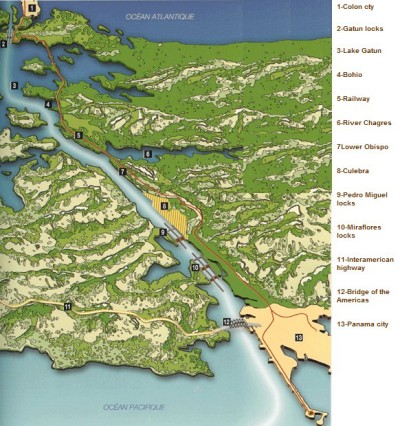 |
13. Which of the following is
not a lock at the Panama Canal?
a) Miraflores Lock
b) Omar Torrijos Lock
c) Gatun Lock
d) Pedro Miguel Lock
Answer:
b) Omar Torrijos Lock
|
| |
|
14. The man who helped convince
Teddy Roosevelt of the necessity of building the Panama
Canal was:
a) Alfred Thayer Mahan
b) James Monroe
c) Benjamin Franklin
d) Thomas Jefferson
e) William McKinley
Answer:
a)
Alfred Thayer
Mahan
Alfred Thayer Mahan was
a Naval officer who won fame as a Naval historian and as the leading
Naval strategist of his day. Mahan was called "the most
important American strategist of the nineteenth century." His concept of "sea
power" was based on the idea that countries with greater naval power
will have greater worldwide impact. His ideas still permeate the
U.S. Navy Doctrine.
When Mahan
published his famous naval doctrine, "The Influence of Sea Power
upon History, 1660-1783" in 1889, Theodore Roosevelt read the newly
published book over a single weekend. Roosevelt never forgot
what he learned from the book. Roosevelt completely agreed the
United States would need to protect its sea lanes of interest around
the world to become a great nation.
Thanks to the ideas of
Mahan, Roosevelt
became obsessed with naval power. Sea
power was necessary to facilitate trade and peaceful commerce,
therefore, the country with the greatest sea power would be able to
wield great influence on the world stage. Therefore, long
coastlines, good harbors, and power over the Suez and the soon-to-be
Panama Canal was essential.
|
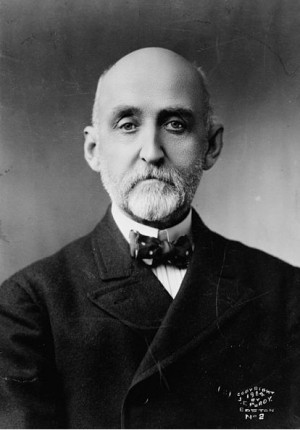 |
| |
|
15. America's construction of
the Panama Canal was in serious trouble from the start. The
man who helped rescue the project was:
a) Theodore Roosevelt
b) John Frank Stevens
c) William Gorgas
d) Joseph Bishop
e) George Washington Goethals
f) all of the above
Answer:
f) all of the
above
The French
failed miserably over the ten year period when they worked
on the canal. 1904, the first year of American
involvement, saw the Americans make the exact same mistakes
plus some of their own. The project was in terrible
shape and seemingly doomed to failure.
Amazingly, a
series of men stepped up and took turns saving the massive
project from the jaws of defeat. To read the entire
story, click
History of Events.
|
| |
|
16. Besides being the narrowest
country to separate the Atlantic from the Pacific, what
other feature made Panama attractive for putting the Canal
there?
a) a pre-existing railroad
b) an enormous lake used for crossing
c) a deep river requiring no dam
& no dredging
d) flat land that was easy to dig
e) lowest spot on the Continental Divide in Central America
f) a long canyon that
required no digging
g) all of the above
Answer:
a) a pre-existing
railroad
Thanks to the
California Gold Rush in 1849, the Americans discovered the
fastest way to get from one side of the U.S. to the other
was to head straight to Panama. The Old Panama
Railroad was completed in 1855.
When the French
decided to build their canal in 1880, the presence of the
railroad was a big factor in their decision to use the
Panama route over the Nicaraguan route that had many
advantages of its own.
Not only did the
Panama Railroad run alongside the important Chagres River,
the jungle had already been cleared.
|
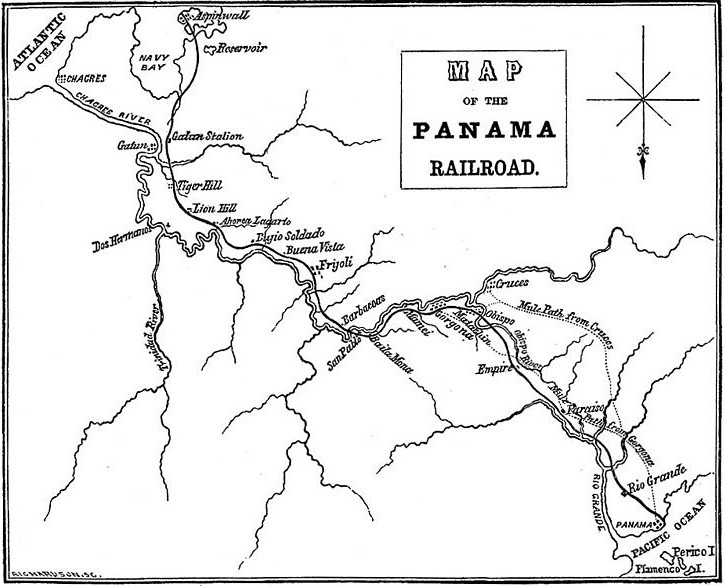 |
| |
|
17. What was the biggest
obstacle to completion of the Panama Canal?
a) disease
b) need to cut a gap through a mountain
c) a highly uncooperative river
d) need to construct untested locks
e) need to construct massive dams
f) lack of a lake for water
g) all of the above
Answer:
g)
all of the above
The Panama Canal
was an incredibly difficult project for that day and age.
If you add the ten years the French invested, it took 20
years to complete the canal. Whatever could go wrong
did go wrong. Its completion was quite an
accomplishment.
|
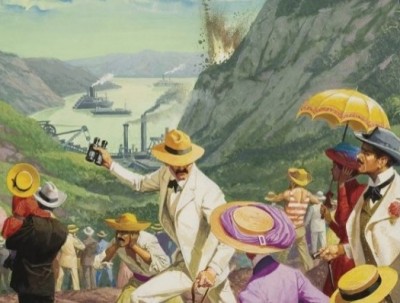 |
| |
|
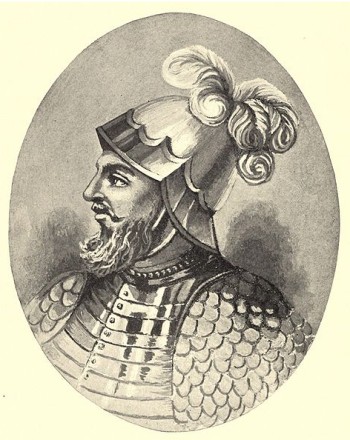 |
18. The man who conquered Panama
was a...
a) Spanish nobleman
b) Spanish explorer/sea captain
c) Spanish stowaway
d) Spanish map maker
e) Spanish conquistador
Answer:
c) Spanish stowaway
Vasco Núñez de
Balboa (1475 - 1519) was a
Spanish explorer, governor, and conquistador.
Balboa
is best known for having crossed the Isthmus of Panama to
the Pacific Ocean in 1513, becoming the first European to
lead an expedition to have seen or reached the Pacific from
the New World.
Balboa had very
humble beginnings. His father was a mason.
Balboa had
little education and served first as a page and a squire to
a Lord in Spain. At age 26, in 1501 Balboa hired on as
a crewman on a ship headed from Spain to an area around
Panama. Balboa parlayed his earnings into a farm in
Hispaniola (modern day Haiti and Dominican Republic).
He failed miserably as a planter and pig farmer.
Deeply in debt, he needed to get off the island or go to
jail. In 1509, wishing to escape his creditors in
Santo Domingo, Balboa set sail as a stowaway, hiding inside
a barrel together with his dog.
How Balboa went
from page to pig farmer to stowaway to famous explorer is
one of the great rags to riches stories of the New World.
|
| |
|
19. The ships rise in the locks
by pumping water in to raise the water
level. True or false?
Answer: False
Using water
primarily from Lake Gatun, no water is pumped upwards at the
Panama Canal. The locks work strictly by gravity...
all ships are raised and lowered using water draining into
the Atlantic or the Pacific from the locks.
For a thorough
understanding of the operation, please visit
How
the Locks Work.
|
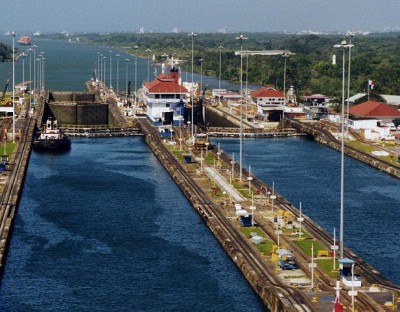 |
| |
|
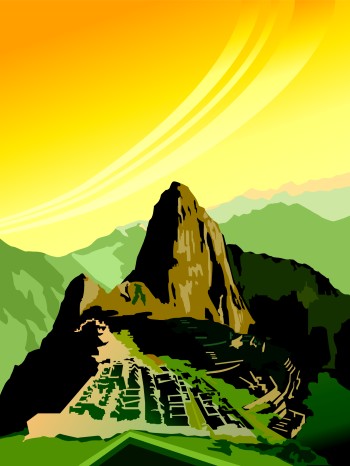 |
20. The Panama
Canal has been described as the Eighth Wonder of the World
and the greatest engineering achievement since the Great
Pyramids of Egypt.
Which of the following is NOT one of the Seven New Wonders
of the World?
| a) |
Chichen Itza |
| b) |
Christ the Redeemer |
| c) |
Roman Colosseum |
| d) |
Great Wall of China |
| e) |
Machu Picchu |
| f) |
Panama Canal |
| g) |
Petra |
| h) |
Taj
Mahal |
Answer:
f) Panama Canal
Hard as it is to
believe, the Panama Canal is the odd man out. You
would think 50,000 workers and 20 years to finish plus the
remarkable ingenuity required would all count for something.
Some people
would add that digging is a lot harder than building.
Nonetheless, the Panama Canal was overlooked. In fact,
it was not even one of the other 13 finalists!!
|
| |
|
21. Central America is defined
as the part of the Americas that links North and South
America together. Which of the following countries is not
considered part of Central America?
a) Belize
b) Mexico
c) Guatemala
d) El Salvador
e) Honduras
f) Nicaragua
g) Costa Rica
h) Panama
i) all the above countries are part of Central America
Answer:
b) Mexico
For various
reasons, Mexico
is considered part of North America along with Canada and
the USA.
|
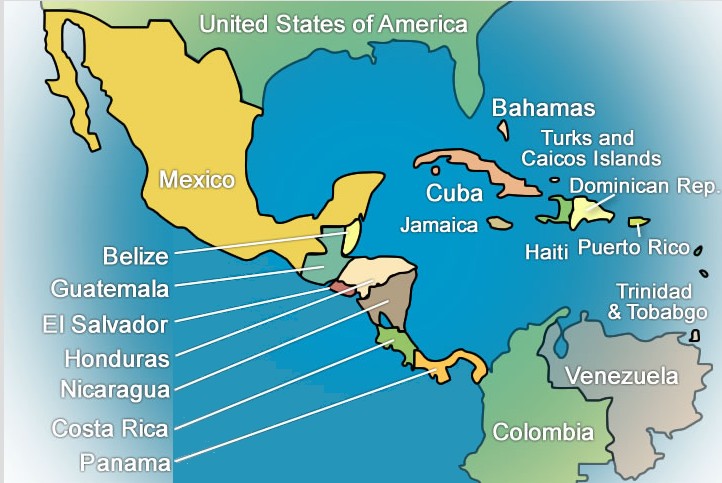 |
| |
|
22. The Chagres River is the
backbone of the Panama Canal. This river is unusual because:
a) It required little dredging to form the Panama Canal
b) It is the only river in the world that flows in two
directions
c) It is the only river in the world that empties into two
oceans
d) It is the only river in the world in the shape of the
letter "T"
e) It has two dams
f) All of the above
Answer: f)
All of the above
The origin of the
Chagres
goes way back into the mountains and jungles of Panama.
You can see the path of the Chagres lightly traced in red.
As you can see, up in the mountains there are about five
different rivers that combine to create the mighty Chagres
River.
Culebra is a
town at the top of the Continental Divide that is underlined
on the map. Culbra was about 300 feet higher than the
Chagres before the Canal was built, so the Chagres was
blocked from flowing towards to Pacific Ocean. It made
its way to Atlantic instead.
However, once a
huge gap was cut through the large hill at Culebra (aka the
Culebra Gap), suddenly the gap was no higher than the
Chagres River.
From this point
on, half of the waters from Chagres flowed towards the
Atlantic and half of the waters flowed to the Pacific.
|
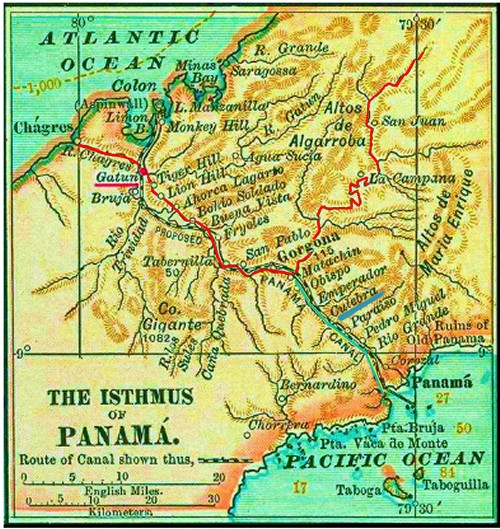 |
| |
|
23. The opening of the Panama
Canal was almost completely ignored.
Why was that?
a) the construction had taken so long no one cared any
more
b) World War I had just started
c) President Woodrow Wilson suffered a major stroke that
left him partially paralyzed
d) It was wiped off the front pages by the infamous Black
Sox baseball scandal
e) all of the above
Answer:
b) World War I had just
started
World War I started
on July 28, 1914. The Panama Canal opened two weeks
later.
The world was
far too stunned to care about anything but the intense
conflict. They figured this war might just mean the
end of all civilization.
|
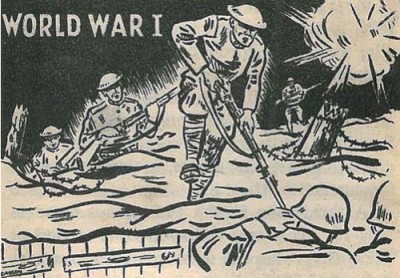 |
| |
|
24.
Including the building of the Panama
Railroad from 1850-1855, the French canal attempt of
1880-1890 and the American canal effort, roughly how many
men are said to have died building the railroad and the
canal?
a) less than 10,000
b) 15,000-20,000
c) 25,000-30,000
d) 35,000-40,000
e) more
Answer:
d) 35,000-40,000
Anywhere from 6,000 to 12,000 men died
from cholera, malaria, and yellow fever building the
railroad.
The French are
said to have lost 22,000 men in their futile ten years on
the project.
The Americans
are said to have lost 5,600 men. So that puts us
somewhere close to 40,000.
By contrast, the
infamous Spanish-American War of 1898 that preceded the
building of the Panama Canal had about 20,000 combined
casualties from both sides.
Apparently
mosquitoes are twice as dangerous as bullets.
Dr. William
Gorgas is the man given credit for reducing the American
casualty rate dramatically.
|
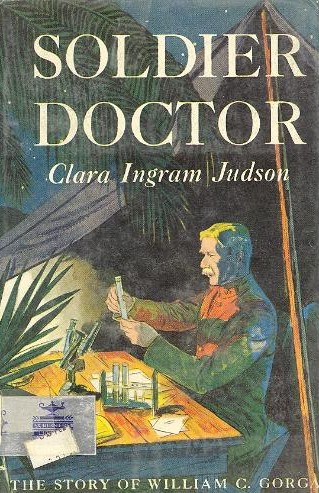 |
| |
|
25. The Panama
Canal has one weakness in particular that worries everyone.
That would be:
a) the size of modern ships
exceeds the size of the locks
b) the rainfall of Panama could easily become insufficient
c) the Canal is far too vulnerable to sabotage and terrorism
d) Panama lies on the San Andreas fault line
e) the nearby volcano Baru is no longer dormant
Answer: b) the
rainfall of Panama could easily become insufficient
Damming the Chagres
River in 1913 created what was
then the world’s largest man-made
lake. Gatun Lake sees Panama and its Canal through the dry
season between January and March. The surrounding rain
forests act as sponges and help conserve water.
However, in passing years, El Nino, climate changes, and
massive deforestation has increased the nation’s
challenge to maintain enough water to service the Canal.
|
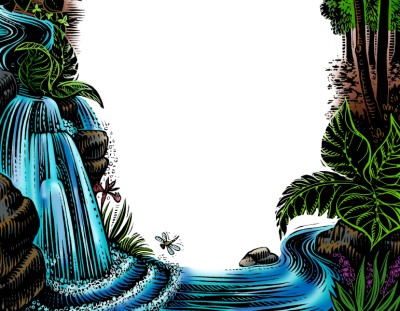 |
|
|
|
|
|
Rick Archer's
Note: This completes my article about the Panama
Canal. I hope you have enjoyed your reading.
If you would like to contact me for any reason, please email
rick@ssqq.com
|
|
|
|
|